Editor's Note: This cover of this week's edition of Automotive News (autonews.com) features a story about GM's pioneering development of the EV "skateboard" and how it set the table for an entirely new direction in the development of the automobile. A variation of the GM "skateboard" is now used by every manufacturer of EVs in the world, and it remains a testament to GM's True Believers in Engineering and Design. In fact, GM has a long history of innovation and pioneering engineering breakthroughs going back to the 1930s. Just one example? The Firebird I, II and III concepts from the '50s were so advanced that many of the features developed for those machines are still found in cars built today. The 1958 Firebird III, for instance, was powered by a 225HP gas turbine engine with a 2-cylinder 10HP gas engine to run the onboard accessories. It had cruise control, anti-lock brakes, air drag brakes, remote opening doors, an automated guidance system, and it was steered by a joystick in the console. There have been other significant engineering programs originating at GM throughout the decades. In fact, what GM is doing today in terms of engineering its new EVs is every bit as breakthrough and innovative as any time in its long history. This week, Peter focuses on one of GM's most significant - and storied - engineering development programs: The 1960 CERV I (Chevrolet Experimental Research Vehicle) and the 1963 CERV II. Both machines were developed under the direction of iconic Corvette chief engineer Zora Arkus-Duntov as a platform to develop and refine Chevrolet body, chassis and suspension systems. At least that was the "official" version. They were really developed, however, as all-out racing machines. As many of you already know, Peter's postings on Twitter (@PeterMDeLorenzo) provide a colorful look at the industry and racing in particular. Peter is a firm believer in historical perspective when it comes to motorsports, and the important stories that need to be told. And we think you'll agree that the CERV I and CERV II are certainly worth noting and appreciating. We hope you enjoy reading about them. -WG
By Peter M. DeLorenzo
Detroit. As many of our readers know, I have a presence on Twitter (@PeterMDeLorenzo). Most - but not all - of my postings on that site involve motorsports, including evocative images from the "glory days" of racing in the 60s and 70s. This week, I wanted to devote some time to the Chevrolet Engineering Research Vehicles, the CERV I and CERV II - and the True Believers responsible for them.
The CERV program originated with Corvette icon Zora Arkus-Duntov, who envisioned it as a platform for engineers to use in order to develop Chevrolet - specifically Corvette - body, chassis and suspension systems. The CERV I was developed between 1959 and 1960 as a functional mid-engine, open-wheel, single-seat prototype racing car. The bodywork was designed by industry legends Larry Shinoda and Tony Lapine.
The CERV I was originally equipped with a fuel-injected 283 cu. in. 350HP small block V8 that weighed only 350 lbs. Intensive use of aluminum and magnesium engine components saved more than 175 lbs. from previous Chevrolet V8s. The body structure was constructed out of fiberglass and weighed only 80 lbs. The body structure was attached to a rigid 125 lb. chrome-molybdenum tube constructed frame, welded in a truss-like configuration. Combining these lightweight components contributed to the CERV I's weight of 1,600 lbs. The 96-inch wheelbase chassis features a four-wheel independent suspension, uses independent, variable rate springs with shock absorbers and stabilizer bar in the front, and multilink, variable rate springs, with double-acting shock absorbers in the rear. The wheels are cast magnesium alloy. Steering is recirculating ball type with 12:1 ratio.
The brake system on the CERV I uses front disc/rear drum, with a two piston master cylinder to eliminate the chance of complete brake failure. Fuel is delivered via two rubber bladder fuel cells (20 gal. total capacity). At one point Duntov refitted the CERV I with a 377 cu. in. aluminum small block, an advanced Rochester fuel injection system and Indy-style tires and wheels. (That 377 cu. in. small block V8 became the mainstay in the Corvette Grand Sport racing program.) To match this mechanical updating, Shinoda redesigned its streamlined body structure for greater aerodynamics. Top speed for the CERV I was 206 mph, achieved on GM's circular 4.5-mile test track at its Milford, Michigan, Proving Grounds.
Excited by its impressive performance potential, Duntov had his eye on bigger things for the CERV 1 - including racing in the Indianapolis 500 - but due to the AMA (Automobile Manufacturer’s Association) ban on manufacturer-sponsored racing at the time - which GM painfully adhered to - the closest Duntov could get to a major showcase for the car was when he drove the machine in a series of demo laps at the U.S. Grand Prix in 1960. (GM)
(GM)
Zora Arkus-Duntov in the CERV 1 at the GM Technical Center test track, 1960.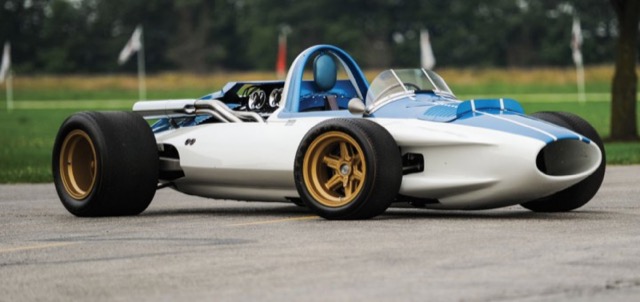 (RM-Auctions)
(RM-Auctions)
The CERV 1.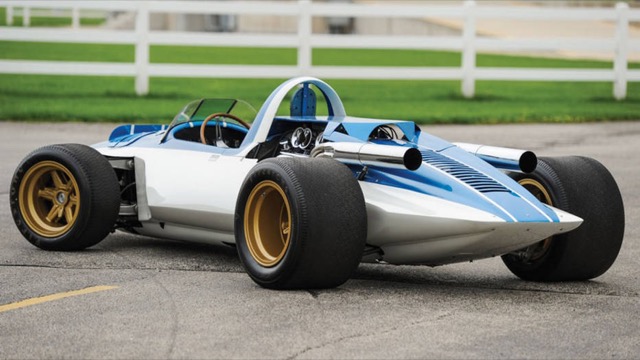 (RM-Auctions)
(RM-Auctions)
The CERV I appeared in the international racing colors - white with blue - assigned to the United States.
The next-generation Chevrolet Engineering Research Vehicle - the CERV II - was conceived early in 1962, developed over the next year and built under Duntov’s direction between 1963 and 1964. By the time it was finished, Duntov envisioned the CERV II as a possible answer to the Ford GT40 racing program. At this point it was also in Duntov's mind to develop a separate line of racing Corvettes to sell, an idea that was later rejected, of course, by GM management. Duntov wanted the CERV II to showcase future technologies as applied to a racing machine.
Chevrolet General Manager "Bunkie" Knudsen wanted to get back into racing so the CERV II was planned for the international prototype class with a 4-liter version of the Chevrolet small block V8. Knudsen has been given strict orders to stay out of racing by upper management at GM, but obviously that didn't dissuade Duntov and his team. Construction was started on the CERV II almost at the same time that the "no racing" GM management edict came down.
As with CERV I, the body was designed by the team of Shinoda and Lapine. The chassis of the CERV II consisted of a glued-together steel and aluminum monocoque with a steel sub frame to carry the suspension and engine. It was powered by a Hilborn fuel-injected, overhead cam, 377 cu. in. aluminum small block V8 with a 10.8 compression ratio and 500HP. By 1970, the CERV II ran a 427 cu. in. ZL-1 V8 with 550HP. Titanium was used for the hubs, connecting rods, valves, and exhaust manifolds helping to bring the total weight of the machine below 1400 lbs.
The CERV’s II engineering of the drive system and torque converter arrangement was handed over to GM’s engineering team and it turned out to be its most fascinating development. The result? An advanced all-wheel drive system using two torque converters. This marked the first time that anyone had designed a variable power delivery to each end of the car, which varied according to vehicle speed. The very wide wheels carried experimental low profile Firestone tires mounted on specifically constructed Kelsey-Hayes magnesium wheels. The ventilated disc brakes were mounted outboard, with the Girling calipers widened to accept the vented rotors.
The CERV II was very quick: 0-60 in 2.5 seconds with a top speed of 190+ mph. During its extensive development Jim Hall and Roger Penske were among the top drivers who wheeled the CERV II.
The plan to use the CERV II as The Answer to the Ford GT40 program ended up being killed by GM management, as was their wont. The CERV II was used as a research tool for a mid-sixties super Corvette program that was also cancelled by management. Never raced, the CERV II ended as a show and museum piece, a tribute to the True Believers at GM Design and Engineering.
Editor-in-Chief's Note: Thank you to the GM Heritage Center for the details on the CERV I and CERV II. -PMD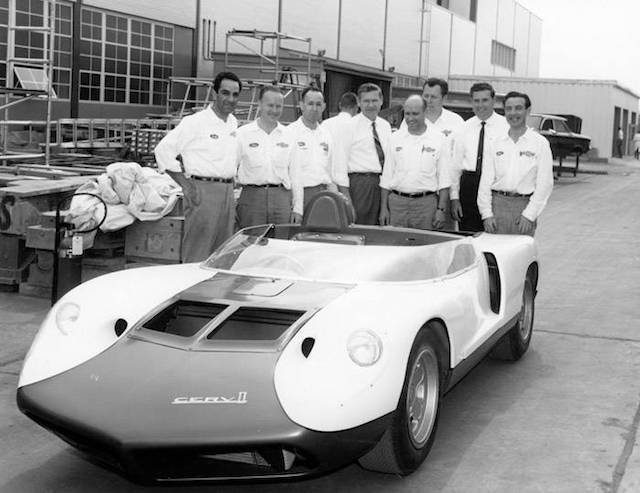 (GM)
(GM)
The True Believers at GM Engineering stand proudly by the magnificent CERV II at its roll out at the GM Technical Center in Warren, Michigan. (GM)
(GM)
Zora Arkus-Duntov in the CERV II, late 1963.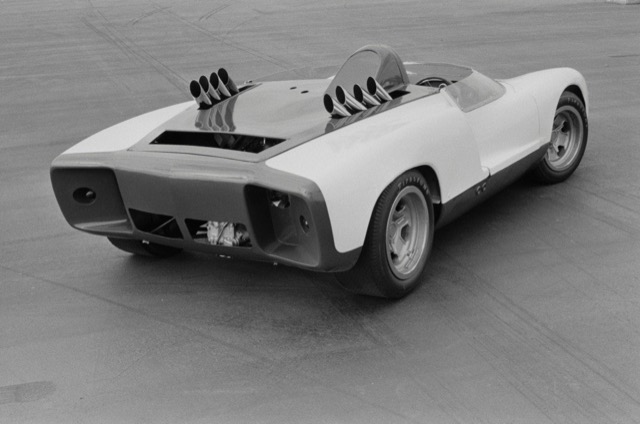 (GM)
(GM)
The CERV II photographed at the famous "Black Lake" at the GM Proving Grounds in Milford, Michigan. (GM)
(GM)
An inside look at the CERV II.
Editor-in-Chief's Note: As part of our continuing series celebrating the "Glory Days" of racing, this week's images come from GM. - PMD
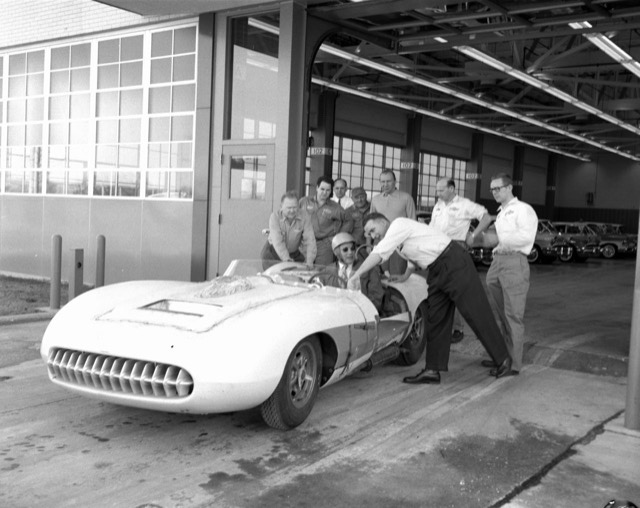 (GM)
(GM)
GM Technical Center, Warren, Michigan, 1957. Zora Arkus-Duntov being wheeled out for the maiden test run of the Corvette SS racing car. GM had a short test track on the Tech Center grounds that saw extensive use.
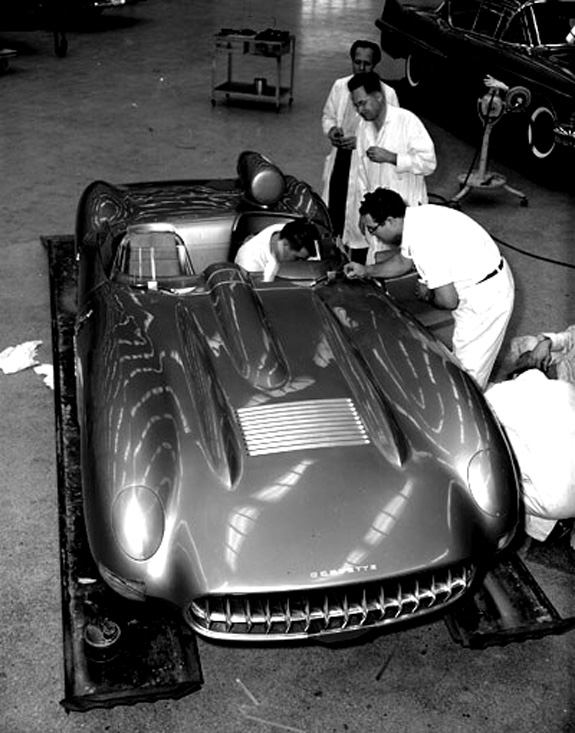
(GM)
GM Technical Center, Warren, Michigan, 1957. The Corvette SS racer being finished before being shipped down to Sebring, Florida, for its racing debut in the 12-Hour race.
Editor's Note: You can access previous issues of AE by clicking on "Next 1 Entries" below. - WG